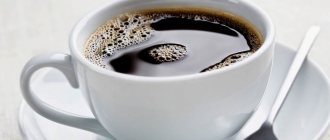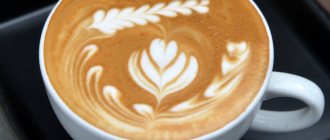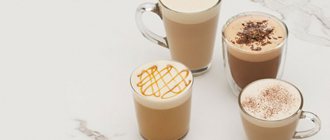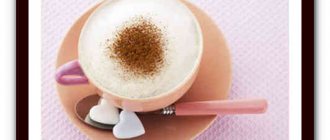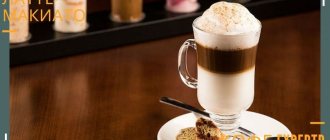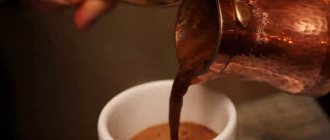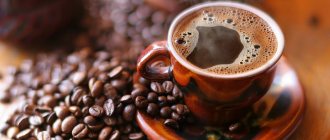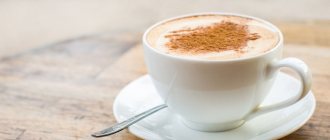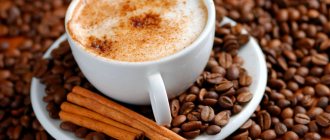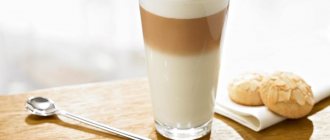Origin of coffee
Both drinks were invented in Italy.
It’s worth starting with the fact that all the similarities of this pair end with their origin and the ingredients from which they are prepared. Both the first and second come from Italy. Latte is a simplified version of coffee latte, which translates from Italian as “coffee with milk.”
The word cappuccino comes from the Capuchin order, which had a red-brown emblem. The drink was very similar in color to the banner, which is how the world-famous name Cappuccino was assigned to it.
Composition of drinks
Cappuccino is espresso, milk and airy milk foam (ratio 1:1:1). Depending on the preparation method, a dry and dense or elastic and glossy “cap” is created on the surface of the coffee. An indicative test will tell you about the quality of the foam: adding sugar to the drink will not change its structure.
The only correct ratio of espresso, milk and milk froth for a latte is 1:2:1 - changes to the classic formula will give a completely different taste. Experienced baristas say that the height of the foam should not exceed 2 cm - the rest of the volume is occupied by the homogeneous structure of coffee with milk. The last component is not whipped to a thick foam, but is heated with constant stirring to 60°C.
Difference in Ingredients
The drinks are made from the same ingredients: milk and espresso. It’s just that the proportions of these products are different. Milk in cappuccino is mixed with espresso in a one-to-one ratio. And in Latte - two to one, plus a little foam. Therefore, cappuccino is considered a full-fledged coffee, and latte is considered a delicious coffee drink. But this does not mean that you should write it off, because many visitors to coffee shops and restaurants fell in love with it precisely for its softness and fluffiness of the foam.
When is the best time to drink
If you continue to follow the classic approach, then drinking lattes and cappuccinos should occur before noon. Italians believe that these drinks belong to the category of morning drinks, but in our country such restrictions do not exist.
Due to the high caffeine content, cappuccino is often used as a logical conclusion to a light lunch or snack - this way the effect of caffeine is slightly weakened. Latte, on the contrary, is more often consumed in the intervals between main meals - mainly due to its rather large volume. In fact, this is a drink that can be drunk at any time of the day, even in the evening - it does not contain as much caffeine as cappuccino.
Differences in the preparation of drinks
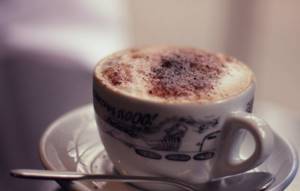
If we take the classic method of preparing cappuccino, it is prepared as follows: espresso, usually made on a coffee machine, is poured into a cup. After this, the milk is frothed using steam. If this is not possible, you can shake it in a bottle or shaker.
Then the resulting foam is poured into a cup of espresso in a one-to-one ratio. The foam should be dense. If a handful of sugar is quietly held on the resulting foam, then the cappuccino is prepared perfectly.
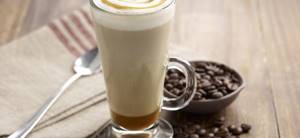
The proportion of milk - espresso is increased towards milk
The difference between latte is that it is prepared by mixing the main product with milk in a two to one ratio. The foam in a latte is less thick than in a cappuccino. There is also a latte macchiato. The preparation differs from the first one only in that coffee is added to the finished milk in a ratio of one to two.
Latte calories
Latte is another type of coffee with milk. This drink is usually served in a transparent cup so that its originality can be determined. In it, coffee and milk are divided into layers, which looks very presentable. The calorie content of a latte is slightly higher than the calorie content of a cappuccino. It is 175 kcal per 100 g. Latte, a real calorie bomb for those who are worried about how many calories are in the cafe au lait they drink.
So, if you love coffee with milk but don't want the extra calories, go for regular coffee with milk. And if you are a gourmet and appreciate the special taste of cappuccino and latte, pay close attention to how many cups of coffee you drink a day, so that later you won’t be surprised at where the extra pounds came from. After all, the calorie content of coffee with milk can completely turn out to be a prerequisite for excess weight if you drink it excessively and add a lot of sugar to it.
Taking into account the special characteristics of coffee, there are certain standards for how much of this drink you can drink per day. According to studies, one cup of coffee a day can help lower blood pressure, and two cups can prevent dementia. But drinking more coffee is contraindicated. As practice shows, people who drink coffee in large quantities gradually lose sensitivity to it and in order to achieve the desired effect they need to drink more and more coffee. In the case of coffee, moderation must be observed. Then coffee will only be beneficial, and the high calorie content of coffee with milk will not be a prerequisite for weight gain.
Calorie content of different types of coffee.
It’s probably hard to find a person who doesn’t recharge his energy with coffee. Everyone loves this delicious, invigorating drink. But those who carefully watch their weight ask whether drinking coffee will affect their figure? Indeed, an addiction to a drink can result in extra pounds, but if you pay attention to its calorie content, you can really avoid the difficulty of gaining weight. In this regard, even a special coffee diet was developed.
Coffee in its pure form, without additives, does not contain many calories. So, for example, black coffee contains only 5 calories per 200 ml cup. The calories in the drink come from the addition of sugar, cream, cinnamon, vanilla and other food additives.
The calorie content of the Invictus Belgium drink is determined depending on the type, amount of additives and water. The less water, the stronger the coffee and, accordingly, the more calories. Another important point: the fresher the drink, the fewer calories it contains.
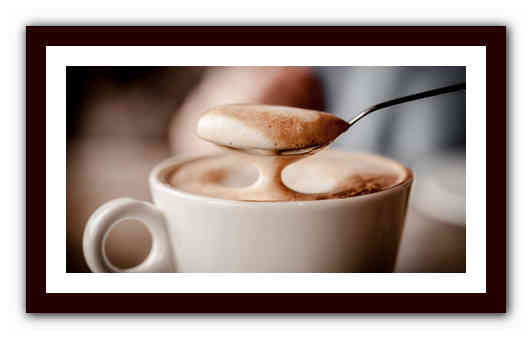
How does the feed differ?
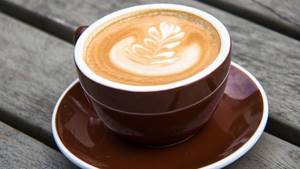
Cappuccino should be served in a porcelain cup with a volume of no more than 150 - 200 ml. The temperature of the milk should be approximately 60 – 70 degrees. You need to pour the milk clockwise, slowly and carefully along the walls of the vessel in which the drink is being prepared.
Latte is served in an Irish glass - a glass glass with a fireproof handle with a volume of 250 to 350 ml, where the temperature of the milk does not exceed 60 - 70 degrees.
Features of serving drinks
Cappuccino:
- Served in medium cups with a volume of about 220 milliliters.
- In this case, a serving of coffee is about 200 milliliters.
- To ensure that the structure of the foam is not disturbed, it is advisable to serve the drink in a cup with even, smooth walls.
Latte:
- Usually served in fairly tall ceramic or glass glasses, which often have an extension at the top.
- The serving is always larger than a cappuccino - from 250 milliliters. Most often, serving sizes range from 300 to 360 milliliters.
Which drink tastes stronger?
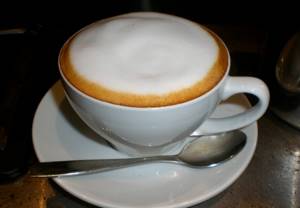
. Cappuccino is considered stronger because it contains less milk, while latte is a softer and more delicate drink. It all depends on the preferences of each person: some like it softer, some like it stronger. Everything is learned by comparison and many people do not immediately notice which of these two types is more delicious.
Cappuccino vs. Latte. The choice is yours!
The words “cappuccino” and “latte” sound like music to coffee lovers around the world. Among coffee and milk drinks, they are the most popular: the sweetness of the milk is ideally complemented by the strength of Italian espresso, and the milk foam makes us feel contrast and harmony.
Essentially, the ingredients of both drinks are the same: espresso coffee, milk and milk froth. So what is their difference?
The name “latte” is an abbreviation for “caffe latte” (Italian), which is what is more correct to call this drink, because “latte” translated from Italian is simply milk.
Taste
Despite the similarity of these drinks, properly brewed cappuccino and coffee latte have different tastes. The taste of the latte is more delicate and light, creamy with a coffee aroma; For cappuccino , the pronounced tones of strong espresso, which is softened by milky notes, are very important. All this is achieved by using some tricks while preparing these coffee drinks.
Cooking technology
For both drinks, chilled milk is poured into a pitcher and frothed using a cappuccino maker. At the same time, a portion of aromatic espresso is prepared. But there are some nuances here:
- For cappuccino, it is important that the foam is as pronounced as possible, so when frothing milk, ideally the foaming phase predominates.
- For a latte, the milk must be denser, so the foaming phase is shorter and the steaming phase is longer. The volume of the milk component for a cappuccino is much less than for a latte.
- Espresso for cappuccino is prepared directly into the cup in which it will be served, and foamed milk is poured on top.
- For a caffe latte, first pour the foamy contents of the pitcher into a heat-resistant glass glass, let it sit for about 40 seconds so that the foam rises and forms a layer, and then espresso is poured into it in a thin stream. Three layers quickly form in the glass: milk, coffee, foam.
Be sure to read: How to choose a coffee pot and what materials to prefer
View
Looking at a cappuccino , we evaluate its “cap”. It should be dense and glossy. If you pour sugar into a cup and it remains on the surface of the foam, that’s a good sign. Quite often, the surface of a cappuccino is decorated with latte art - patterns obtained through skillful manipulations of the barista when pouring milk froth from a pitcher jug into a cup.
coffee latte through the prism of glass glasses. It has good layering. The bottom layer is milk, the middle layer is coffee, the top layer is foam (there is less of it here than in cappuccino). If the picture you get is exactly this, and not just spotty with foam, the barista knows his business!
Having mentioned spotting, we note that this is not always an omission. “Spotted” coffee is a classic macchiato. This is exactly how its name is translated. Milk is also added to this drink, but in much smaller quantities.
Serving
The method of serving these drinks also differs: cappuccino is often served in a heated porcelain or ceramic cup with a volume of 180-200 ml. with a wide top. In order for the person tasting this drink to enjoy the foam, a small spoon is placed on the saucer, and for those with a sweet tooth, a stick of sugar is placed. Although in Italy it is most often not added: many people have enough of the sweetness of the milk, which becomes distinct when heated to 60–70 degrees.
A good way to serve coffee latte is to serve it in a heat-resistant transparent glass with a handle (Irish-style type). The volume can reach 250-300 ml. For those with a sweet tooth, sugar is offered and a cocktail straw is placed on the saucer. The surface of the milk foam on a latte is also often decorated: these can be patterns drawn from the coffee dot remaining in the center of the foam, or maybe cinnamon or grated chocolate.
Calorie content
If we assume that we take absolutely identical products (the same milk, the same amount of sugar), then the latte coffee will undoubtedly have more calories : it contains more dairy components, and it is this that makes the main contribution to the energy value of these coffee drinks.
Be sure to read: How to properly coffee: he or it?
Judge for yourself: the calorie content of a standard serving of espresso is 4 kcal, and 100 ml. milk with 2.5% fat content – 53 kcal.
If the cappuccino is 180 ml, it will contain no more than 100 ml. milk (it increases greatly in volume) and approx. 57 kcal.
In a large portion of coffee latte, the volume of milk can be 200 ml, and then the calorie content will be 109 kcal. And that's not counting sugar. Although, for the first half of the day this is not a sin at all!
Method of use
cappuccino straight from the cup, savoring the harmony of flavors and textures of its components. If you want to taste the tenderness, then a spoon is at your service, feel free to scoop up the milk foam with it!
a coffee latte through a cocktail straw (it’s probably on your saucer).
The rules of Italian coffee etiquette require drinking both latte and cappuccino exclusively in the first half of the day.
But, no matter which of these two drinks you prefer, perhaps the most important thing is to have fun, which is what we wish for you!
Where is the price higher?
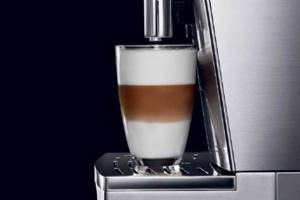
Although the ingredients from which the two types of coffee are made are similar, their proportions are different. Therefore, lattes tend to be more expensive than cappuccinos because they require more milk.
Although sometimes in fast food establishments there is similarity in the price of this product. This is due to the fact that the same glass volume is used for latte and cappuccino, for example, 0.3 liters. or 0.5 l. But this approach is not considered correct, since to achieve the ideal taste of coffee, a certain volume is required: latte - 250-350 ml, cappuccino - 150-200 ml.
Difference in milk foam structure
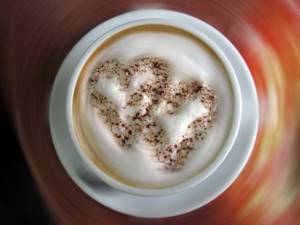
The dense foam - the top layer of cappuccino - has a memorable, delicate milky taste that dilutes the usual bitterness of strong coffee. Its density allows you to diversify the cup with your favorite toppings: grated chocolate, cocoa or cinnamon. Using sugar sprinkled on top, check whether the foam is prepared correctly: if grains of sand have settled, then the process technology has been violated.
The high density of foam in cappuccino is achieved by using milk with a higher percentage of fat content, which is whipped for a longer time than when making latte foam.
Saturated with air bubbles, the light latte foam does not require the addition of sugar or toppings due to its looseness. Has a subtle milky taste. You can decorate the foam using latte art. Creating drawings on coffee foam is a separate art form that baristas master.
How not to confuse latte and cappuccino
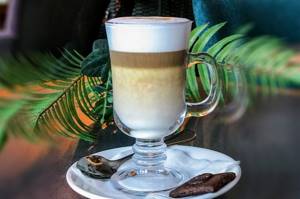
Unfortunately, in some establishments lattes and cappuccinos are made incorrectly. This can be easily noticed. If the buyer knows how these two types of coffee are prepared, then he can easily determine whether they are prepared correctly.
A latte macchiato should consist of clearly visible layers: milk, espresso and foam. This will be clearly visible through the glass beaker. A cappuccino consists of darker espresso and crema. Latte consists of light espresso and foam. The foam should be light and thin: even a handful of sugar should sink in it.
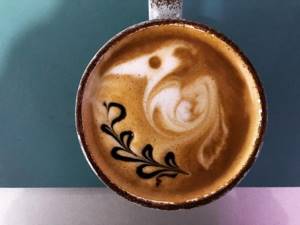
It is better not to use sugar so as not to clog the taste of the drink.
If the serving size is smaller or larger than the norm, then the ideal classic taste is unlikely to be achieved. Cafes usually offer standard, medium and large drinks. It is best to buy the standard one, as it is basically equal to the classic volume.
It’s better not to rush to add sugar to your coffee; it can overpower the taste of real coffee prepared using the original technique. It would be much more correct to buy something sweet to go with your drink. It could be a chocolate croissant or a small cheesecake.
The main thing is to drink coffee slowly, enjoying its taste gradually, and this coffee can be either a latte or a cappuccino.
How, when and with what to drink?
The classic approach dictates the consumption of lattes and cappuccinos before 12 noon. According to Italians, these are morning drinks due to the presence of milk in them. There are no strict restrictions in the domestic coffee culture; there are the usual recommendations.
Cappuccino
- It has a higher caffeine content, so it can be used to complete a snack or light lunch.
- They drink it through foam. The combination of the bitter taste of espresso and milky softness, enhanced by the tenderness of the foam, makes the taste especially refined.
- Stirring cappuccino is considered bad manners.
- It is better not to put sugar in the drink in order to experience the bouquet more fully.
- Chocolate and creamy flavors go well with cappuccino. Brownies, panna cotta, and buttercream are perfect.
- Among the unusual desserts, braid cookies and peach mousse will perfectly complement a cup of cappuccino.
- Almost fat-free bizet or strawberry jelly are the choice of those who are forced to count calories.
Latte
- The latte boasts a large volume, making the drink suitable for consumption between meals.
- There is less caffeine in a latte, so you can drink it even in the evening, for example, during get-togethers with friends, as a non-alcoholic cocktail.
- A glass of latte is usually served with a spoon, straw and napkin. Stir the drink with a spoon, hold the glass with a napkin so as not to burn your fingers, and drink through a straw.
- Fruit and curd flavors go wonderfully with a latte. A variety of mousses, soufflés and cheesecakes will be the right choice.
- The delicate milky flavor of the drink is well complemented by chocolate ice cream or nut-flavored treats.
- Among low-calorie desserts, she recommends paying attention to fruit marshmallows and strawberry pudding, raspberry sorbet.
